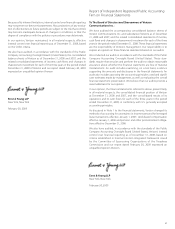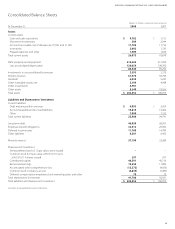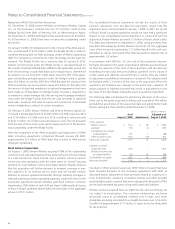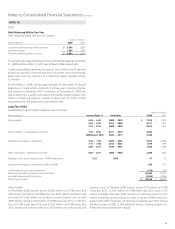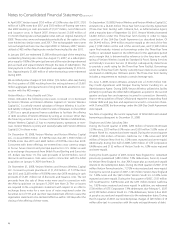Verizon Wireless 2008 Annual Report Download - page 48
Download and view the complete annual report
Please find page 48 of the 2008 Verizon Wireless annual report below. You can navigate through the pages in the report by either clicking on the pages listed below, or by using the keyword search tool below to find specific information within the annual report.46
Employee Benefit Plans
Pension and postretirement health care and life insurance benefits
earned during the year as well as interest on projected benefit obliga-
tions are accrued currently. Prior service costs and credits resulting from
changes in plan benefits are amortized over the average remaining ser-
vice period of the employees expected to receive benefits. Expected
return on plan assets is determined by applying the return on assets
assumption to the market-related value of assets.
As of July 1, 2006, Verizon management employees no longer earn
pension benefits or earn service towards the company retiree medical
subsidy (see Note 15).
In September 2006, the FASB issued SFAS No. 158, Employers’ Accounting
for Defined Benefit Pension and Other Postretirement Plans—an
amendment of FASB Statements No. 87, 88, 106, and 132(R) (SFAS No. 158).
Effective December 31, 2006, SFAS No. 158 requires the recognition of a
defined benefit postretirement plan’s funded status as either an asset or
liability on the balance sheet. SFAS No. 158 also requires the immediate
recognition of the unrecognized actuarial gains and losses and prior
service costs and credits that arise during the period as a component
of Other accumulated comprehensive loss, net of applicable income
taxes. We adopted SFAS No. 158 effective December 31, 2006, which
resulted in a net decrease to shareowners’ investment of $7,409 million.
This included a net increase in pension obligations of $2,007 million, an
increase in Other Postretirement Benefits Obligations of $10,828 million
and an increase in Other Employee Benefit Obligations of $31 million,
offset by an increase in deferred taxes of $5,457 million. Additionally,
plan assets are measured at fair value as of the Company’s year-end.
Derivative Instruments
We have entered into derivative transactions to manage our exposure
to fluctuations in foreign currency exchange rates, interest rates and
commodity prices. We employ risk management strategies which may
include the use of a variety of derivatives including cross currency swaps,
foreign currency forwards and collars, equity options, interest rate and
commodity swap agreements and interest rate locks. We do not hold
derivatives for trading purposes.
In accordance with SFAS No. 133, Accounting for Derivative Instruments
and Hedging Activities (SFAS No. 133) and related amendments and inter-
pretations, we measure all derivatives, including derivatives embedded
in other financial instruments, at fair value and recognize them as either
assets or liabilities on our consolidated balance sheets. Changes in the
fair values of derivative instruments not qualifying as hedges or any
ineffective portion of hedges are recognized in earnings in the cur-
rent period. Changes in the fair values of derivative instruments used
effectively as fair value hedges are recognized in earnings, along with
changes in the fair value of the hedged item. Changes in the fair value
of the effective portions of cash flow hedges are reported in other com-
prehensive income (loss) and recognized in earnings when the hedged
item is recognized in earnings.
Recent Accounting Pronouncements
In December 2008, the FASB issued FSP FAS No. 132 (R)-1, Employers’
Disclosures about Postretirement Benefit Plan Assets (FSP 132 (R)-1). FSP
132 (R)-1 requires Verizon, as plan sponsor, to provide improved disclo-
sures about plan assets, including categories of plan assets, nature and
amount of concentrations of risk and disclosure about fair value mea-
surements of plan assets, similar to those required by SFAS No. 157. FAS
132 (R)-1 is effective for fiscal years ending after December 15, 2009. We
do not expect that the adoption of FSP 132 (R)-1 will have a significant
impact on our consolidated financial statements.
In April 2008, the FASB issued FSP No. FAS 142-3, Determination of
the Useful Life of Intangible Assets (FSP 142-3). FSP 142-3 removes the
requirement under SFAS No. 142, Goodwill and Other Intangible Assets to
consider whether an intangible asset can be renewed without substan-
tial cost or material modifications to the existing terms and conditions,
and replaces it with a requirement that an entity consider its own histor-
ical experience in renewing similar arrangements, or a consideration of
market participant assumptions in the absence of historical experience.
FSP 142-3 also requires entities to disclose information that enables users
of financial statements to assess the extent to which the expected future
cash flows associated with the asset are affected by the entity’s intent
and/or ability to renew or extend the arrangement. We were required
to adopt FSP 142-3 effective January 1, 2009 on a prospective basis. The
adoption of FSP 142-3 on January 1, 2009 did not have an impact on our
consolidated financial statements.
In March 2008, the FASB issued SFAS No. 161, Disclosures about Derivative
Instruments and Hedging Activities – an amendment of FASB Statement
No. 133, (SFAS No. 161). This statement requires additional disclosures
for derivative instruments and hedging activities that include how and
why an entity uses derivatives, how these instruments and the related
hedged items are accounted for under SFAS No. 133 and related inter-
pretations, and how derivative instruments and related hedged items
affect the entity’s financial position, results of operations and cash flows.
SFAS No. 161 is effective for financial statements issued for fiscal years
and interim periods beginning after November 15, 2008. The adoption
of SFAS No. 161 on January 1, 2009 did not have an impact on our con-
solidated financial statements.
In December 2007, the FASB issued SFAS No. 141(R), Business Combinations,
(SFAS No. 141(R)), to replace SFAS No. 141, Business Combinations. SFAS
No. 141(R) requires the use of the acquisition method of accounting,
defines the acquirer, establishes the acquisition date and broadens the
scope to all transactions and other events in which one entity obtains
control over one or more other businesses. This statement is effective
for business combinations or transactions entered into for fiscal years
beginning on or after December 15, 2008. Upon the adoption of SFAS
No. 141(R) we will be required to expense certain transaction costs and
related fees associated with business combinations that were previously
capitalized. This will result in additional expenses being recognized
relating to the 2009 closing of the Alltel transaction. In addition, with
the adoption of SFAS No. 141(R) changes to valuation allowances for
deferred income tax assets and adjustments to unrecognized tax ben-
efits generally will be recognized as adjustments to income tax expense
rather than goodwill.
Notes to Consolidated Financial Statements continued



